I’ve lived a fair bit of my life in the city of Pune and it’s a very special place to me. I first moved here in 2012 to study medicine at the Armed Forces Medical College (AFMC), an institution to which I owe a lot. Between adjusting to new life and its rules, studying anatomy and finishing an obligatory 10-kilometre run at the historic Race Course right opposite our college, I was also extremely interested in the history of the college I was studying at. I learnt that AFMC was founded not in 1962 (as undergraduates often believed), but in 1948 – with its first campus at Eve’s Estate (God knows where that was or who Eve was – some suggested it was named after the wife of an industrialist land-owner) before it shifted to its current location – the 150-year old Connaught Barracks of Wanowrie.


We’d spend our Sundays outside, often trying to escape the summer heat by going to a park for the shade. One such park was the Bund Garden, on the southern bank of the Mula-Mutha river, named after the fact that it was built adjacent to a ‘bund’ (बंद in Hindi and Marathi) – a local word for a dam or an embankment. The Bund was built in the 1850s by the famous Parsi industrialist Jamsetjee Jejeebhoy (of Mumbai’s JJ Hospital and JJ School fame). On reading up about the bund in Pune online, I discovered that there was also an area known as “The Bund” in Shanghai. It was an expensive waterfront area, lined by fancy hotels and multinational bank headquarters. I wondered if the two of them were connected in any way, or if the word “Bund” meant the same thing in Shanghai as it did in Pune. As it turned out, the answer was yes.
As I read up about the Bund in Shanghai, I found interesting connections between Pune and Shanghai, which I reexplored recently after having a conversation with a colleague who studied medicine in China and spent a considerable amount of time walking by the Bund in Shanghai.
But before we get into those connections, here’s a little background.
Baghdad to Bombay
In the 1830s, a Jewish trader named David Sassoon arrived in Bombay from Baghdad and started selling Persian carpets. Soon, he expanded his business, becoming a middleman between British textile firms and commodity merchants from the Persian Gulf. He eventually became one of the richest industrialists of Bombay and, by the end of the 1850s, it was said of him that, “silver and gold, silks, gums and spices, opium and cotton, wool and wheat– whatever moves over sea or land feels the hand or bears the mark of Sassoon and Company.”
In 1833, the British administration decided to end the monopoly of the British East India Company in the opium trade with China. Soon, every industrialist wanted a piece of the action. Opium was banned in China, and foreign trade heavily regulated. In addition, the British could only trade with the Chinese at a single port (Guangzhou). For this reason, opium obtained from poppy flowers grown in India was smuggled into China, in exchange for tea – a commodity of great value in Britain and increasingly in India.
In 1839, a standoff between Britain and China turned nasty, and it led to a full-blown war – known as the First Opium War. The war came to an end in 1842, at which point the Chinese government surrendered and signed the Treaty of Nanking – agreeing to pay the British 21 million pounds in war reparations, ceding them the island of Hong Kong , and opening up more ports for the British to trade at – one of which was Shanghai. Land was given in the city of Shanghai to western powers – Britain, France and the United States, for them to build enclaves.
After the Treaty of Nanking, David Sassoon expanded his trade in China, and soon the Bombay-based David Sassoon & Co. opened up branches all over Asia and beyond – from Manchester to Yokohama. David was joined in business by his sons Abdallah (later ‘Albert’) and Elias.
David, the patriarch and arguably the most famous member of the Sassoon family (and perhaps the subject of a future blog post), passed away in 1864, and his business passed into his sons’ hands with Abdallah ‘Albert’ Sassoon as its chairman. Sibling rivalry got in the way of things and Elias Sassoon started a rival company called “E. D. Sassoon & Co.” which started trading in foods, opium and cotton, eventually opening an office in Shanghai. In 1907, the British and Chinese governments came to an agreement to stop supplying opium to China – which led E. D. Sassoon & Co. to completely stop its opium trade over a decade and instead focus on the cotton mill business in Bombay.
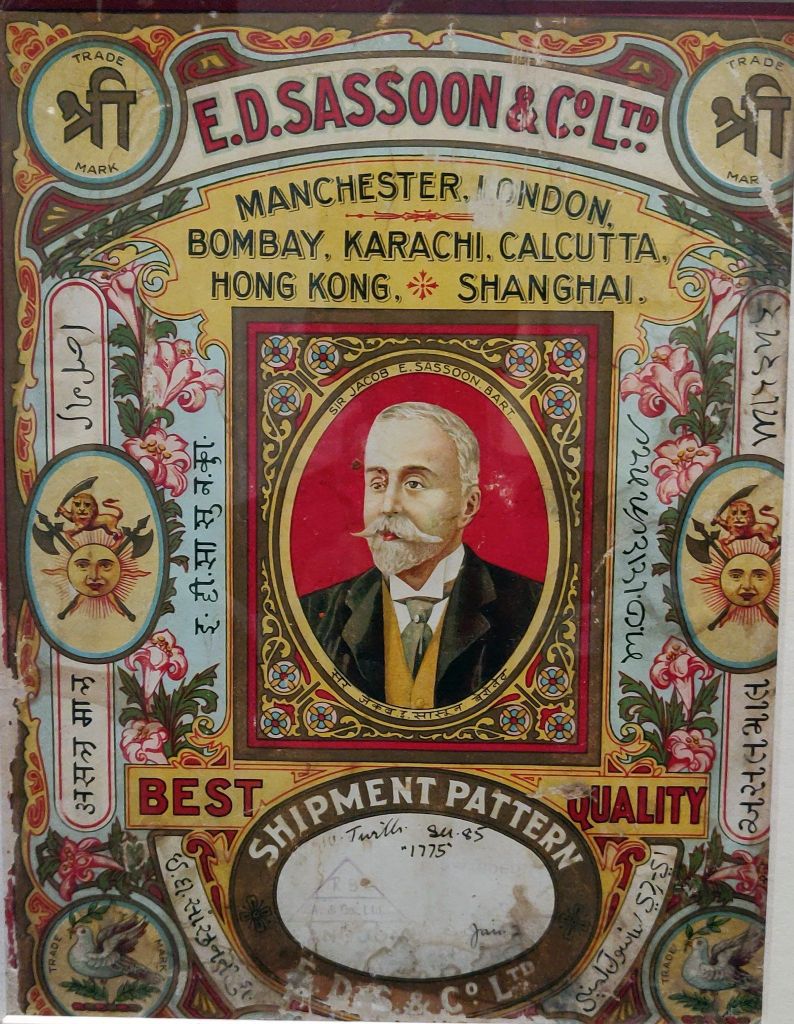
Photograph: Debbasish Das, from a DAG exhibition at the Red Fort in 2019.
After Elias’s death, the family business was taken over by his sons – first Jacob and then Edward. After Edward’s death in 1924, the control of E. D. Sassoon & Co. went to his son Victor.
Victor Sassoon
Ellice Victor Elias Sassoon, or ‘Victor Sassoon’, as he was better known, was born in 1881 in Naples, Italy – where his parents had stopped enroute to India from Britain. He was raised in England and educated at Harrow and Cambridge, while his father worked in the family business back home in Bombay. After completing his education, he was sent to Bombay and Shanghai to help out with the family business, and young Victor soon acquired the image of a playboy – pursuing women, horses and wealth. In 1914, when the First World War broke out, he volunteered and served in the Royal Flying Corps, but his aviation career was cut short in 1916 by a crippling injury to his leg that plagued him for the rest of his life, forcing him to walk with the help of a cane.

Picture: thatsmags.com
He returned to Bombay after the war, eventually becoming a textile baron and an influential figure in Bombay’s and Poona’s horse-racing circles, being one of the chief patrons of the Poona Club. After his father’s death in 1924, he took over the family business and also the baronetcy of Bombay, becoming Sir Victor Sassoon.
In the 1920s, E. D. Sassoon & Co. were the largest textile mill owners in Bombay. But India of the 1920s was a politically uncertain place and in the midst of an ever-growing independence movement, and Victor thought he should move his business elsewhere, and so, he decided to shift his business – lock, stock and barrel – to Shanghai.
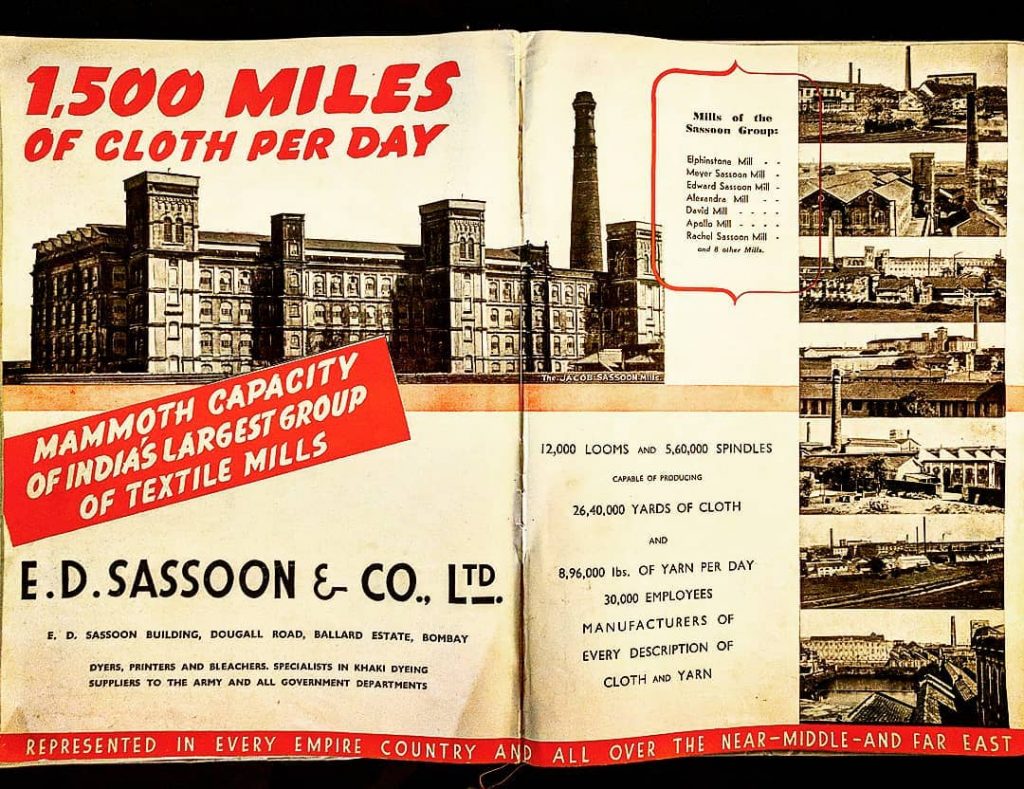
Photograph: Dr Shekhar Krishanan, from his post “Inside Indu Mills: A Textile Museum for Mumbai”.
Shanghai
Since 1845, the British had an enclave or ‘concession’ in Shanghai, which merged in 1863 with the American concession to form what was called the Shanghai International Settlement, located north of a tributary of the Huangpu river.
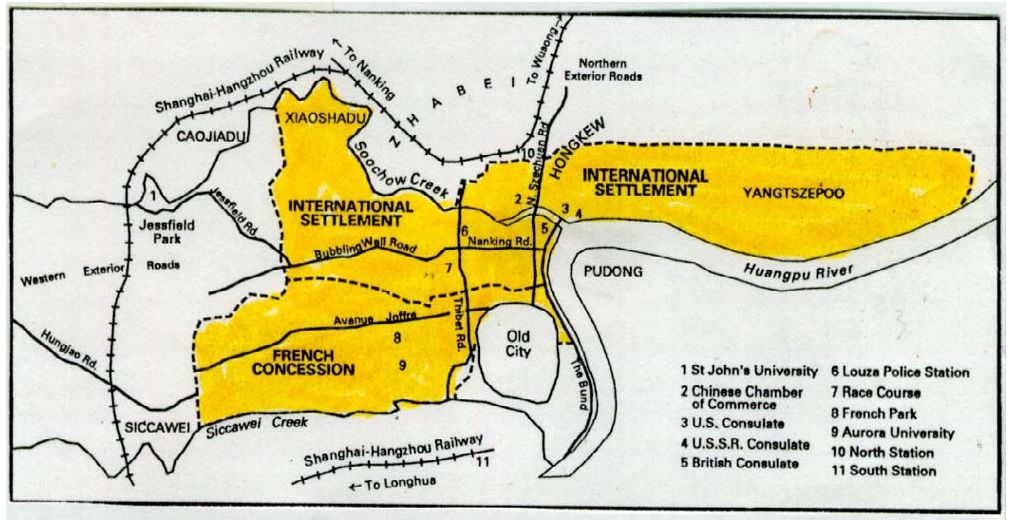
Eventually, as the western influence in the city grew, the area south of the tributary on the western bank of the Huangpu river started seeing development in the 1920s, and one of the most influential men involved in this was Victor Sassoon.
In the 1920s, Victor started investing the profits from the textile mills in Bombay into real estate in Shanghai. An embankment (or ‘bund’ – a term coming from the Indian community there) had been previously built along the marshy western riverbank, and Victor built several prominent buildings along the bank of the river in various architectural styles – neoclassical, Gothic, Baroque, and art deco to name a few. By the early 1930s, this area, known as ‘The Bund’, was home to headquarters of several banks, fancy hotels and social clubs where elite socialites would flock from afar and dance the night away with fancy cocktails in their hands. Soon, Shanghai came to be known as Paris of the Orient.
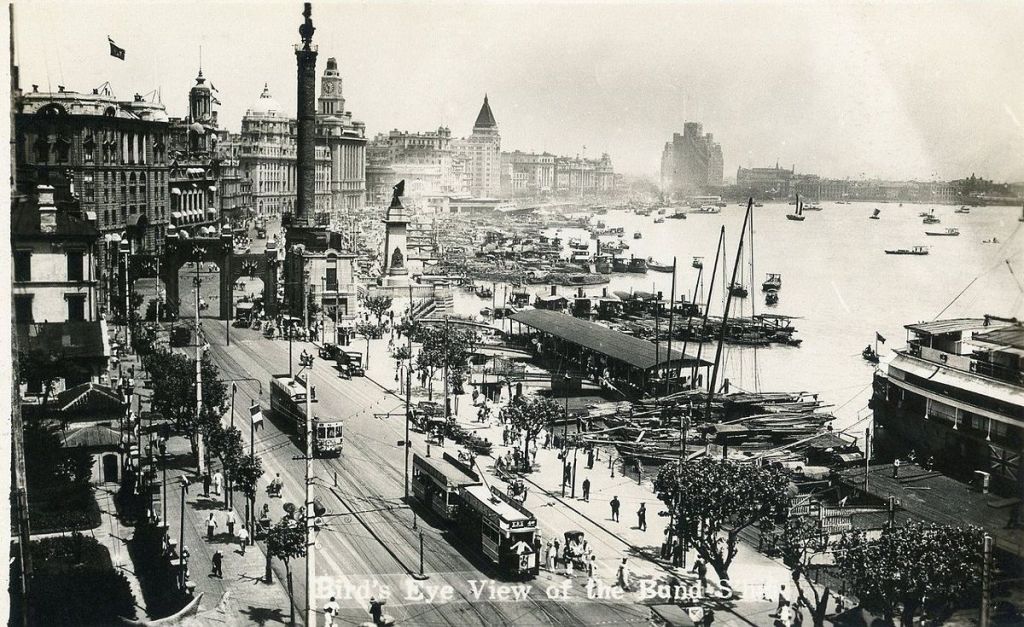
One such prominent building was the Sassoon House, an art deco building facing the Bund and one of the first skyscrapers anywhere in the eastern hemisphere. It housed offices for E. D. Sassoon and Co., as well as the Cathay Hotel – a luxury hotel that was widely known as ‘the number one mansion in the far east’. The Cathay Hotel hosted several distinguished guests from across the world – including Charlie Chaplin and Marlene Dietrich. The top floor of the building housed a penthouse which served as the private residence of Victor Sassoon.
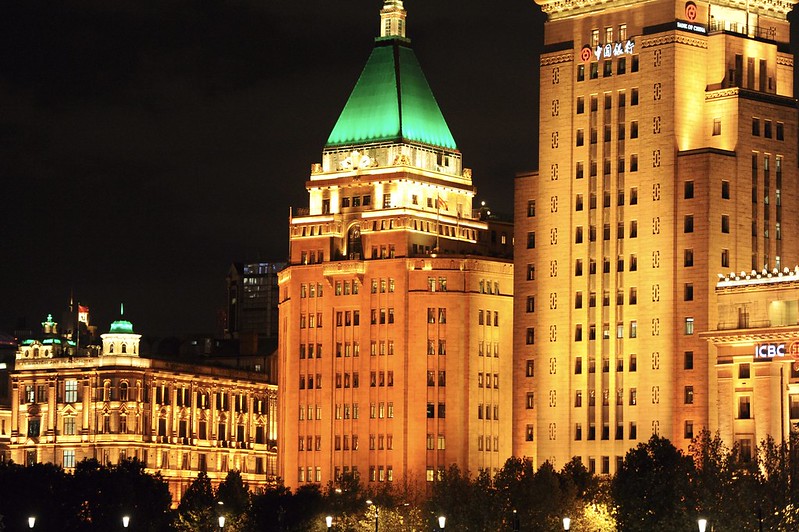
Photograph by Maxwell Fung.
Victor, who was obviously a wealthy man, also maintained another residence in the city – at Hongqiao Road, an arterial road that today connects central Shanghai to the airport towards the west. Today, ten miles west of the Bund lies the Shanghai Zoo, which once used to be a golf course that Victor would frequently visit. So he purchased a house next to the golf course. Named ‘Eves‘, the house was built in a typically English mock-Tudor style.

Picture from the archives of Southern Methodist University, Dallas, USA.

Photograph by Daniel Case.
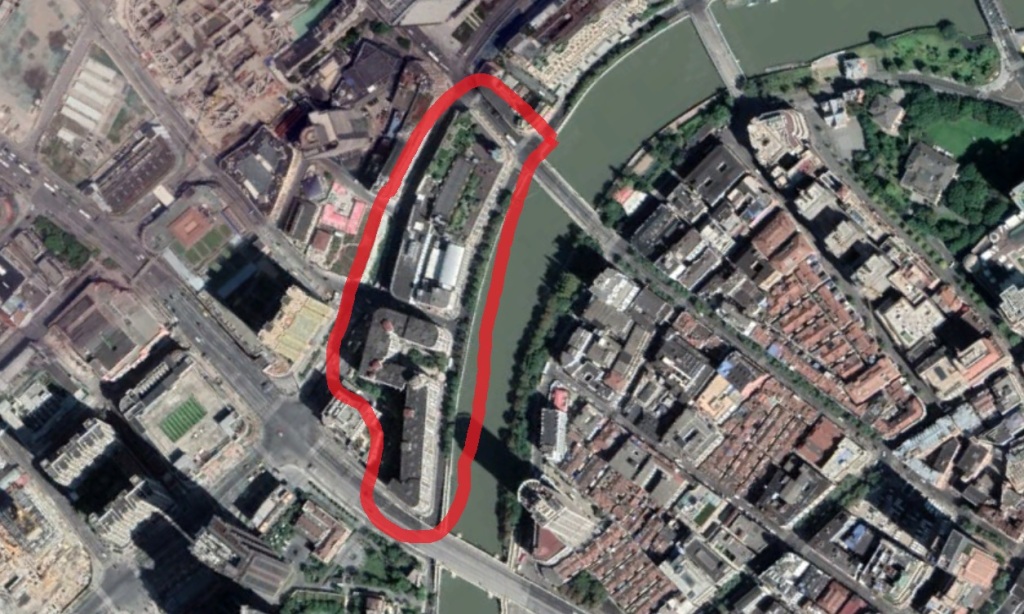
Poona
Victor would make frequent trips to India, spending most of his time here in Bombay and Poona. He was a horse-racing enthusiast, with significant contributions to the activity in India.
The Poona Club (formerly the Poona Gymkhana) was a sporting and recreational club established in the 1860s for the rich, the royals and high-placed British officialdom. It is believed that even Mark Twain visited the club when he was in the city, travelling through India, in 1896. In the 1930s, the club enjoyed significant patronage from Victor, who once allegedly remarked, “There is only one race greater than the Jews. And that’s the derby.”
Most of the early horseracing in India generally involved imported horses — from England, Australia and the Middle East. Some amount of breeding was happening in India, but most of it was for the needs of the army and not for commercial interests. In fact, the indigenous bred variety was called “the country-bred,” and this was a derogatory term used for a horse born in India. The “country-bred” eventually transformed into the “Indian Thoroughbred”, largely due to the contributions of Victor Sassoon, who started a scheme in conjunction with the Royal Western India Turf Club, to give an impetus to indigenous breeding of thoroughbreds.
He also started a 2000-metre annual race called Eve Champion Trophy, that runs to this day – with recent winners including horses named Bushtops (2019) and Selfie Star (2018).
Victor was fond of staying at large country estates away from the city centre. Just like in Shanghai, his property in Poona was on the outskirts of the city, on Solapur Road near the village of Hadapsar, about a mile east of the race course. As I read up in detail about his life, I discovered that this particular property was called “Eves Estate”, and at that moment, I said to myself, “Wait a minute, hold on! Isn’t that where the original campus of AFMC was?” A little bit of digging about its location confirmed that that is exactly what it was!
I felt a rush of blood unlike any other. This is the exactly the sort of stuff that gets me excited! I’m a colonial history enthusiast, and every single time I discover colonial-era connections between cities in India and abroad, I get really fascinated. And this was much more than just that. It was personal. It was about my own alma mater.
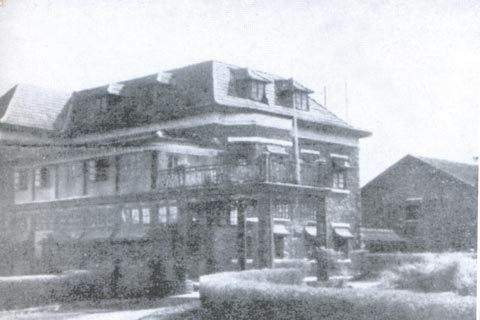
Photograph: AFMC.
Reading a bit more, I confirmed that , as was intuitive, Eve’s Estate and Eves Estate were the same thing. The house was indeed called “Eves” and Victor Sassoon was also known to his friends and family as “Eve” (this is where Eve Champions Trophy comes from). So, Eves Estate and Eve’s Estate were interchangeable terms.
But it really made think: why this name in particular? Why were his residences – both in Shanghai and in Poona – called “Eves“? What does it really mean? Where does “Eves” really come from?
I found the answer in a book on Jewish heritage in western Maharashtra, which was confirmed by an online exhibit on the website of the library of the Southern Methodist University in Dallas – which possesses a commendable collection of artefacts from Victor’s life. The answer is quite simple and elegant when you really think about it. You remember Victor’s full name, don’t you?
Ellice Victor Elias Sassoon. And “Eve”, as Victor was also known, was a further contraction of that.
Today, Eves Estate in Pune houses the Army Institute of Physical Training, which trains instructors to organise and deliver physical training and sports coaching across the Indian Army. Before that, it was briefly the location of the Armed Forces Medical College (from 1948 to 1951). It absolutely blows my mind when I think of the fact that the original campus of the college I went to, barely a mile east of the present campus where I spent five years of my life, was once the private residence of the man who is said to have changed the face of Shanghai. How bizarre is that?!
This post is inspired by a friend who loves exploring unlikely commonalities among apparently very dissimilar cities.
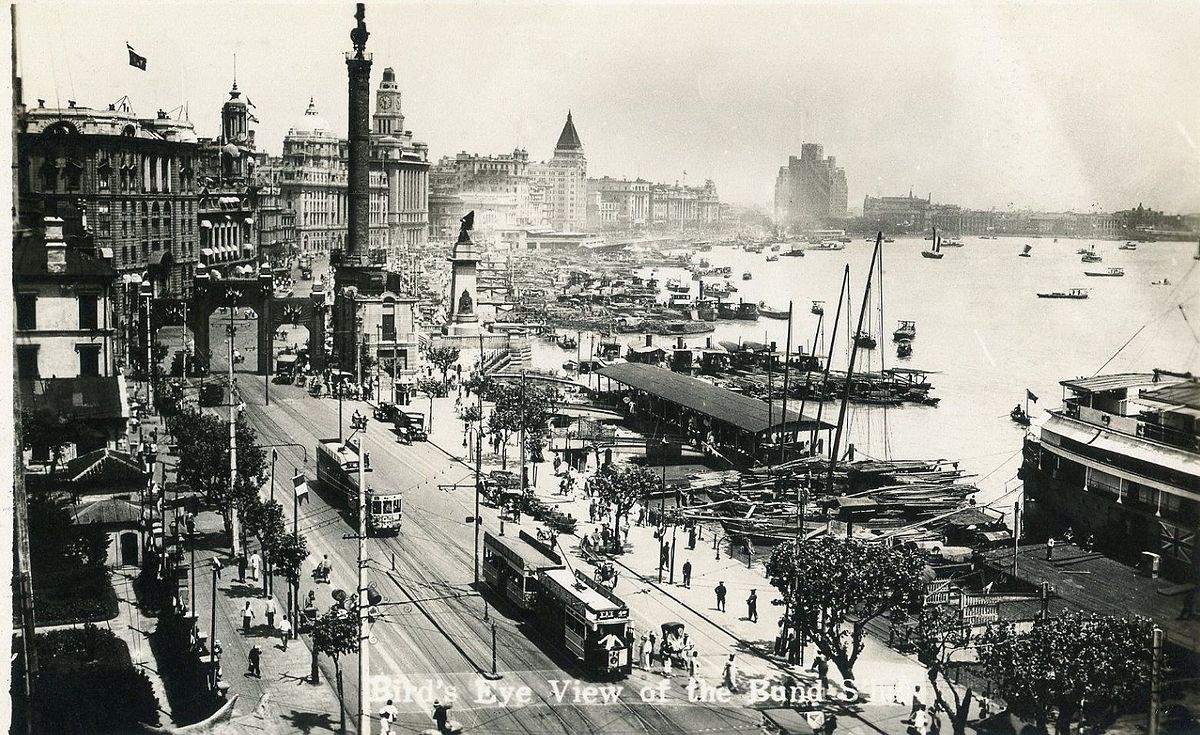
99 replies on “Pune, Shanghai, and a Man Named Victor”
Evocative and interesting style of writing. Wonderful to read about Pune’s landmarks and the history behind them.
LikeLiked by 1 person
Dear Anmol, It’s a small world. My father was the Legal Adviser and Company Secretary of E.D. Sassoon in India and his offices were in E D Sassoon Building at Ballard Estate (now called INDU House after some of their mills went to India United. Was fascinated to read about the family history and of course it brings back many memories. Would love to speak with you at some time. Best regards, Homi
LikeLiked by 1 person
Wow, a small world indeed! I would love to connect with you. Please feel free to email me at anmoldhawan@gmail.com 🙂
If you have any memorabilia or any stories, I’d especially love to hear from you. Thank you so much for reaching out and commenting. I’m glad you enjoyed this piece!
LikeLike
Hi Anmol
Loved your article ‘Pune Shanghai’. I’m from C C batch of AFMC and I feel so proud of you. I’m a Puneite and have been residing in Pune since 1951 when I was 5 years old.. I studied at CJM now St. Anne’s and St Mary’s Pune. I have so many memories but can’t put them on paper like you. There were 2 Jewish girls in my class Shirley Cohen and Sarah.. The synagogue always fascinated me. Thankyou so much for all the research you have done about all these areas of Pune.
LikeLiked by 1 person
‘Twas great to read, brought goosebumps to my skin! I am a graduate of GMC (JJ Hosp) and have had the privilege of Commanding AFMC.
LikeLiked by 1 person
I’m glad you liked the piece, sir. 🙂
LikeLike
[…] Pune, Shanghai, and a man named Victor ( Syndrome) […]
LikeLike
Hello Anmol, what an intense read, thorough research and beautifully written. How come we never new about our Alma Mata! Proud of you! God bless.
Dr Bandita
LikeLiked by 1 person
Very well written and interesting article.Could’nt stop myself from wanting to know more about such old connections.The article has given me a good tour of Pune and Shanghai .Keep it up.
LikeLiked by 1 person
Well written 👍
LikeLiked by 1 person
Very interesting history connection between poone n shanghai
I love History
LikeLiked by 1 person
Exquisitely paced piece! You have the gift, dear fellow, and I am glad you are putting it to good use. Being a history buff myself and from the L batch at AFMC, this was a delightful read to say the least. Need to savour other offerings in your blog.
I wonder if you know that there is a piece of history hidden underground between the gate next to Dhanvantari auditorium and somewhere behind the present library building?
May your fingers remain supple on the keyboard!
LikeLiked by 2 people
Thank you so much, sir! And no, I certainly do not know about that! You can choose to reply to me at my email anmoldhawan@gmail.com for that story, sir 🙂
LikeLike
I wonder if you know that there is a piece of history hidden underground between the gate next to Dhanvantari auditorium and somewhere behind the present library building?
Chandu, you’re going underground now. No excavations permitted. I’m sure many worms will do crawl out of the woodwork as many skeletons tumble out of the cupboard, If only….
We (L Batch) were probably lucky to have studied in the Institution before major renovation works were outlayed nor approved
LikeLike
Excellent & Exciting excavation ! You r find is so amazing . Also to think A Jew was at the top of it all !
A great race .
This would make a marvellous Biopic ! Why don’t you go for that now ?
LikeLiked by 1 person
Thank you Anmol for a beautiful write up on link between Pune and Shanghai, with our alma mater in between. Your narration in gripping. Keep writing
LikeLiked by 1 person
Very interesting. I have walked the Bund in Shanghai and have lived in Pune close to AFMC and this related history is fascinating
LikeLiked by 1 person
Thanks Anmol. A great piece indeed. Although I had fairly good idea about the Opium wars and formation of Hongkong, I had no idea about the Sassoon connection . Your thorough research to reveal the connection of AFMC & AIPT and the Sassoon’s estate is really revealing. Thanks for this interesting write up.
LikeLike
An amazing research in history of Pune and AFMC!!! Astonishing work done as an early career physician. Mind blowing.
Kusum Guglani Kathpalia. G batch.
LikeLiked by 1 person
Great article Anmol
LikeLiked by 1 person
Very very interesting and informative read. Actually the AFMC started as a post graduate training college affiliated to University of Poona.. It was later on added the graduate course Medical Colleage with Batches named A, B, C, D and so on. I did my PG MCh Plastic Reconstructive Surgery in 1980 and Headed The AFMC Deptt. Of the same specialty from 1991 to 93.
LikeLiked by 1 person
Anmol , thoroughly enjoyed the article and though I am not an alumni , however, have been treated by a number of them 😀. Your inquisitive nature augurs well for future patients. Fair winds and happy landings
LikeLiked by 1 person
Great wealth acquired in Hong Kong, based around control of Hong Kong Power and Light.
LikeLike
Totally riveting. Not just in tracing the career of one of the more flamboyant businessman of his era, but in making Victor Sassoon the prototype of the Playboy who could also retain his grip on his financial empire.
LikeLiked by 1 person
An excellent article which has delved in the past of an institution and also the people who did business in the British era.. However I find no mention of the origin of Sassoon Hospital Pune.. It must have had its origins from the Sassoon family.
History of the past gives one goosebumps when reading it.
Thank you Anmol for your write up. My wife is from the C Batch of AFMC
LikeLike
An excellent article which has delved in the past of an institution and also the people who did business in the British era.. However I find no mention of the origin of Sassoon Hospital Pune.. It must have had its origins from the Sassoon family.
History of the past gives one goosebumps when reading it.
Thank you Anmol for your write up. My wife is from the C Batch of AFMC
LikeLike
Congratulations on a superbly written and well researched article. I am originally from Pune and grew near Bund Garden. Many years ago it was a scenic location with a children’s park, boat rides, and a gazebo where students from the blind school sang every Sunday evening. Over the last 20 years I have visited exciting Shanghai many times and always wondered about the name “Bund”. On one visit I actually found the Bund – it was a fixed low level dam, but now it is got a retractable metal wall to better control water flow. I always stay at the Astor House hotel located behind the Russian Consulate which is marked on the map. Keep up the great writing!
LikeLiked by 1 person
Wow! Loved reading it. Learnt a lot.
LikeLiked by 1 person
Thank you Rajenki!
LikeLike
Hi Anmol,
Enjoyed reading your very informative and interesting article.- but more than anything, I was trying to remember all the people who commented on your article as I had taught many of them while being a faculty member in the Anatomy Dept of AFMC from 1965-1991.Just thought I would say ‘Hello’ to all of you through this letter-Mam Doc
LikeLike
Hi Dr Behroze! Thank you for your kind words. It’s very cool that you taught at AFMC for perhaps a whole generation! You must have also taught my parents (X batch) – they joined in 1985!
LikeLike
Fascinating piece,wonderfully articulated,hugely enjoyable.
LikeLike
Thank you so much. I’m glad you liked it. 🙂
LikeLike
Hi Anmol,
Really interesting. I worked at Pune know these places. I have traveled many times to Shanghai and of course visited the Band man times. There are some good Indian restaurants around the band as well. But never thought about this connection. Unbelievable, glad 😊to know of it….
LikeLike
I’m glad you enjoyed it 🙂
LikeLike
Hi Anmol, Great write up after an intensive research. Proud of you Anmol. I am from A Batch AFG-84. It is theUnder Graduate wing of AFMC that was inaugurated on 4th Aug 1962 by then Defence Minister of India VK Krishna Menon. Prior to this AFMC was exclusive for P G studies as mentioned by you.
I have photographs of that event with me and also the pic of stamp released by GOI on 50 years of AFMC UG Wing
LikeLike
Hi Anmol – came to Poona at aged three – am now 94 years old – and left in 1950 aged 20 years. Many happy years at the Convent of Jesus and Mary – when we often cycled to the Bund and sat on the wall – my mother a nurse at Dr. Cowasjee’s and Mil Hos. and private nursing – lived in Khawn road, Staveley road and Napier road – My Farther a Dr IMD – been racing and dancing at the Turf Club, often at the Poona Club – worked at the SLC Exam Board and many happy memories of Poona. Thelma Cramb (nee Ferguson) An interesting article.
LikeLike
Thank you so much for this message. This has totally made my day. You must have seen Pune completely change in front of your eyes, and I would love to get to know more about the Poona that you’ve grown up living in 🙂
LikeLike
Came across this today by sheer luck. What a beautifully written article connecting Shanghai with Pune, and the Victor story !
Realized one thing: the word ‘Bund’ might have come from a marathi word ,’ Bandhara – pronounced as बंधारा ‘ for a Dam, but not too sure about this.
LikeLike
Dear Anmol – also have made a comment on the Article of the Two Synagogues – remembering also the Capitol and Westend Cinemas – and Muratores- kind regards – Thelma Cramb
LikeLike
I ll be honest, i was on a busy night shift in the ED, and uour article kept me riveted, and i nearly dozed off after reading thru the same, but i did read it and enjoyed it thoroughly, you do for certain are gifted, make the best use of it, and keep us posted about more interesting stories about the almamater…good luck, best, Kalyan. H2.
LikeLike
Thank you sir 🙂
LikeLike
Shabash! That is excellent research and to someone who spent the bulk of my twenty years in India in Pune as a base names resonated. I usually like to immerse myself in the literature of any country I have work responsibilities in so you had my full attention in this. After leaving India in 1985 I was located in Singapore as a base caring for the Asia Pacific region and did the same there so reference to China was equally interesting to me. There was a time in history when Indians and Chinese considered themselves friends but reality set in when the contest over territories in the north and north east destroyed that trust.
LikeLike
This was the most brilliant article I’ve probably read ALL YEAR long! It’s been written FANTASTICALLY, Sir you’re QUITE the story teller! I felt like I was with you when you were piecing it together and finding all these connections! Every single sentence had me HOOKED. Thank you for taking the time out to WRITE this and share it. I can’t wait to see what more you come up with!
PS- I’m the (obssessive) investigator myself, so if you ever get a lead, you know whom to call (since I’m mostly always free for just about anything- as long as it isn’t work I am actually obliged to do).
LikeLike
Thank you so much for reading and for your kind words! Let me know when you’re interested for a heritage walk through Camp! Let’s go together!
LikeLike